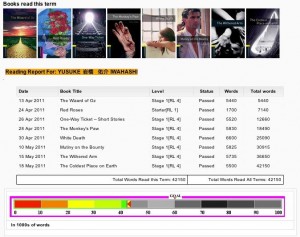Extensive Reading
多読(Extensive Reading)とは、平易な英語で書かれたものを大量に読む学習法です。辞書に頼らずにテンポよくある程度のスピードを保って読むことが大事です。
京都産業大学図書館は、1万2000冊を超える多読本を所蔵しています。多読本はすべてレベルごとに分類されていますので、興味のある内容、そして自分の英語レベルに適した本を簡単に探して読む事ができます。
Extensive Reading is an approach (学習法) where the students read a large volume of easy material. Students should read quickly with little use of their dictionary.
The Sandai library has over 12,000 books divided into reading levels, so that students can select books at their own level that are interesting for them to read.

1万2000冊以上を所蔵する大学図書館
京都産業大学における「多読」の歴史
多読の取り組みが始まったのは1980年代中頃。こちらの記事は、本学科のトーマス・ロブ教授の先駆的研究によって始動したことを伝える資料です。
その後、Accelerated Reader コンピューター・プログラムを導入しました。これによって、単に本を読むだけでなく、読んだ本についての簡単なクイズを受けることが可能になりました。クイズの結果は、読書後のレポートや感想の代わりとしても利用され、学生、教員双方の負担を軽減し読書を促進するものでした。しかし残念なことに、このプログラムには多数の欠点もあり、2008年我々は新たなステージに移行します。 “Moodle Reader”という独自のコンピューター・プログラムの開発に着手したのです。
History of Extensive Reading at San-Dai
ER came to the English Department in the mid-1980s. Here is an article on how it was carried out at that time, without the benefit of “graded readers”.
Later, we adopted the Accelerated Reader computer program. This program allowed students to take short quizzes on the books that they read. The results could be used instead of written reports, so it made the reading task easier for both students and teachers. Unfortunately, the system had many shortcomings, which is why we moved to the next stage, in 2008, where we developed our own computer program “Moodle Reader”.
ムードル・リーダー
多読本を一冊読む度に、内容に関する簡単なクイズを10問 解きます。これに合格するとその本の表紙が個人のページに追加されます。
MoodleReader
After completing each book students take an easy 10-question quiz. When they pass each quiz, the cover of the book is added to their own home page:

A student page on the Mreader.org site which was developed at Kyoto Sangyo.
今日の京都産業大学における「多読」
MoodleReaderは多読教育に役立ちましたが、管理上の難点、クイズだけを利用する教員には複雑すぎる一面もありました。さらに他大学での活用も増加したという背景もあり、Moodleに依存しない新たな”MReader”の開発に着手するに至りました。
詳しくはこちら
Extensive Reading at San-Dai today
MoodleReader, although it served its purpose, was difficult to administer and maintain since access to the software was controlled by SanDai’s computer center staff. This limited out ability to improve its functionality in small steps when we saw the need. Furthermore, the number of users of the software at other universities was slowly growing. Moodle was over-complex for teachers who just wanted to use the quiz program. Thus we set about making a user-friendly, “moodle-free” version which we dubbed “MReader”. (http://mreader.org).

